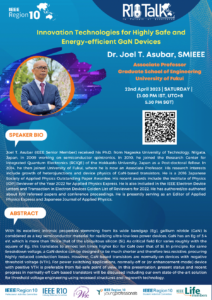IEEE R10 Talk – Innovation Technologies for Highly Safe and Energy – Efficient GaN Devices

- Posted by Yutaro Ishigaki
- Posted in R10 Today
IEEE R10 Webinar Series – “IEEE R10Talk” is pleased to invite you to attend the webinar on “Innovation Technologies for Highly Safe and Energy-Efficient GaN Devices” by Dr. Joel T. Asubar on 22nd of April, at 3:00 PM (UTC +5:30/ IST).
IEEE R10Talk is a joint endeavor of IEEE R10 Industry Relations Committee, R10 Professional Activities Committee, R10 Young Professionals Committee, R10 Women in Engineering Committee, R10 Student Activities Committee, R10 Life Members Committee and R10 Humanitarian Technology Activities Committee, focus on enhancing the awareness of trending topics for the community.
Date: 22/04/2023
Time: 03:00 PM (UTC +5:30 / India Standard Time)
(Check your local time here: https://www.thetimezoneconverter.com/)
Registration Link: https://ieeemeetings.webex.com/weblink/register/r6100b0ec5795f6b2889e7849f189c821
Speaker: Dr. Joel T. Asubar
Speaker Bio:
Joel T. Asubar received his B.S. Electronics and Communications Engineering degree (silver medalist) from Mapua Institute of Technology, Philippines and his M.S. and Ph.D. degrees from Nagaoka University of Technology, Niigata, Japan, working on semiconductor spintronics. He was a research trainee at Hitachi Central Research Laboratory in Kokubunji, Tokyo working with LD-MOSFETs. In 2010, he joined the Research Center for Integrated Quantum Electronics (RCIQE) of the Hokkaido University, Japan as a Post-doctoral fellow. In 2014, he then joined University of Fukui, Japan as a Senior Assistant Professor, and was promoted to Associate Professor in 2019. Since 2015, he has been a committee member of the IEEE International Meeting for Future of Electron Devices Kansai (IMFEDK) and currently serving as the chairman of the Academic Committee. His research interests include growth of heterojunctions and device physics of GaN-based transistors. He is a 2016 Japanese Society of Applied Physics Outstanding Paper Awardee. His recent awards include the Institute of Physics (IOP) Outstanding Reviewer Award 2022. He is also included in the IEEE Electron Device Letters and Transaction in Electron Devices Golden List of Reviewers for 2022. He has authored/co-authored about 100 refereed papers and conference proceedings. He is an IEEE senior member.
Abstract:
With its excellent intrinsic properties stemming from its wide bandgap (Eg), gallium nitride (GaN) is considered as a key semiconductor material for realizing ultra-low-loss power devices. GaN has an Eg of 3.4 eV, which is more than thrice that of the ubiquitous silicon (Si). As critical field Ecr varies roughly with the square of Eg, this translates to almost ten times higher Ecr for GaN over that of Si. In principle, for same breakdown voltage, a GaN device can be designed to be much shorter and therefore less resistive, procuring highly reduced conduction losses. Moreover, the major advantage of using GaN over Si and its other wide bandgap rivals, is the possibility of fabricating the AlGaN/GaN heterostructure, which is the basis of the high-electron-mobility transistor (HEMT). Strong polarization fields in the AlGaN/GaN heterostructure result in a sheet of highly mobile two-dimensional electron gas (2DEG), serving as current carrier between the drain and source electrodes that can be modulated by an external applied voltage (VGS) on the gate. Because of the inherent presence of this 2DEG in the channel even without applied VGS, AlGaN/GaN HEMTs are normally-on devices with negative threshold voltage (VTH). However, for power switching applications, normally-off or (or enhancement-mode) device with positive VTH is preferable from fail-safe point of view. In this presentation, present status and recent progress in normally-off GaN-based transistors will be discussed including our own state-of-the-art solution for threshold voltage engineering using recessed structures and regrowth technology.



You must be logged in to post a comment.